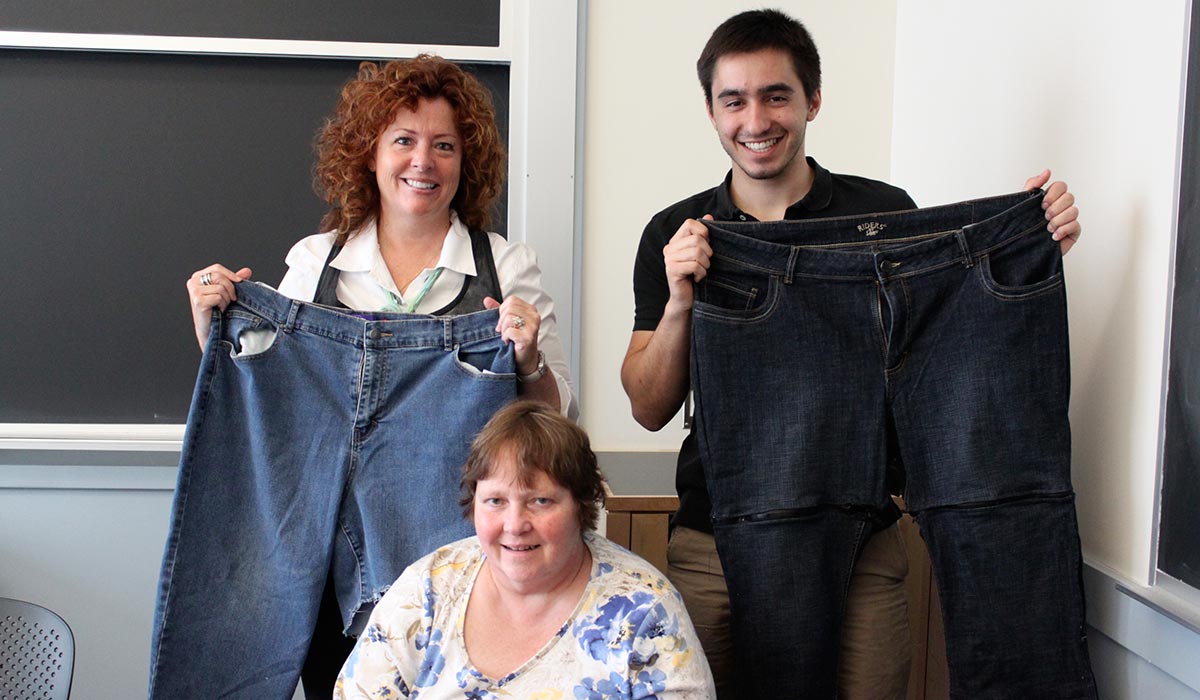Students Create Adaptive Clothing at MIT Open Style Lab

Beth-Ann Latsko and Deniz Aksel present prototype jeans designed for client Barbara Harrison. Photo by Alice Tin.
After a series of fractures left her in unbearable pain, Barbara Harrison elected to have below-the-knee amputation. While she knew the surgery would change her life, she wasn’t prepared for the small changes that nobody thinks about—like how clothes will fit.
Harrison, a Winthrop resident, now has a prosthetic leg, and the process of getting dressed in the morning is more difficult. That’s why a team of college students at Massachusetts Institute of Technology (MIT) are working together to design a new kind of pant that can be functional for people with disabilities.
Creating apparel that is both functional and aesthetically-pleasing is the whole idea behind the MIT Open Style Lab (OSL), a new 10-week summer program where students design clothing solutions for people with physical disabilities. Funded by university grants and corporate sponsors, the program is the brainchild of MIT grad Grace Teo and Brown University medical student Alice Tin.
“Clothing is social capital. Often [clothing for people with disabilities] falls under the functional end of the spectrum and doesn’t look cool or stylish,” Teo says. “What we’ve noticed is even if you have the best intentions, the best product, the most helpful technology, if it doesn’t look great, people don’t want to wear it.”

OSL fellow Alex Peacock’s sketch of a glove for his client who has fisted hands due to a spinal cord injury. Photo by Kira Bender.
Hoping to change this trend, Teo and Tin have recruited 24 engineering, design, and occupational therapy students to this summer’s inaugural OSL program. The students work in teams of three, with each team assigned to one of the program’s eight clients—all of whom, like Harrison, have a physical disability. In the early weeks of the program, which began in June, teams met with their clients to identify specific clothing challenges. Now, students are focused on creating prototypes of their designs under the guidance of expert mentors.
Maura Horton, a professional designer, is one of them. Though her background is in designing clothing for children, Horton’s recent efforts have focused elsewhere. She is the creative force behind MagnaReady, a line of dress shirts for seniors and people with limited mobility that uses magnets instead of traditional buttons. She designed the shirts after her husband, then a 48-year-old college football coach, was diagnosed with Parkinson’s Disease—a debilitating condition which left him unable to dress himself.
“When my husband was first diagnosed, I looked at the [adaptive clothing] choices that were available online. It frightened me,” Horton says. “What I was seeing online was not something I wanted to replicate with my family. They were not quality choices.”
Horton says one of the most important aspects of her “magnet-infused” shirt design, which her OSL students use for inspiration, is that it looks like any other dress shirt available in stores. Unlike other adaptive clothing, it does not differ in appearance from traditional clothing in an obvious way.
“The greater need besides being able to [dress] independently is being able to look like everyone else, or look how you want to look,” Horton says. “Instead of standing out because of your disability, that’s one way that we should be able to all stand on a level platform.”
As founders of the OSL program, Teo and Tin share Horton’s sensibility. The ultimate goal of the program, they say, is to make “the distribution of clothing more accessible.”
“Everyone has a range of clothing to work with because [clothing is] a channel for self expression. For populations with disabilities, that vocabulary is limited,” Tin says. “What we’re doing with Open Style Lab is to reintroduce diversity into their wardrobe.”
Student teams will reveal their final clothing prototypes at a public presentation at MIT on August 16 from 3:30 p.m to 5 p.m. The prototypes will also be presented during weekends in October at Boston’s Museum of Science. For more information, visit openstylelab.com.

Grace Teo and Alice Tin try on goggles that mimic eye diseases at the MIT AgeLab. Photo by Laura Hanson.


